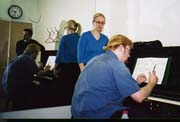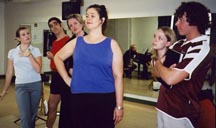 Critical to the process of developing an opera, such as Gertrude Stein Invents A Jump Early On, is the workshop. I begin with the word critical because it suggests critic, a player who is integral to the longevity of any artistic work. Even if the critic is not favorably disposed, a published review by a critic demonstrates that the work merits consideration by the public. Since one cannot control what critics will think, opera collaborators need to test their work and hear feedback before going public. Critical to the process of developing an opera, such as Gertrude Stein Invents A Jump Early On, is the workshop. I begin with the word critical because it suggests critic, a player who is integral to the longevity of any artistic work. Even if the critic is not favorably disposed, a published review by a critic demonstrates that the work merits consideration by the public. Since one cannot control what critics will think, opera collaborators need to test their work and hear feedback before going public.
Theater workshopping invites critical commentary from everyone involved in the creation of the work. Taking the time and money to try out the words, music, and theater dimensions allows for adjustments and further collaborative development of a work before going live and declaring that this is finished work. The Original Vision The original vision for the Stein opera was to create an intimately sized work that would be reproducible in small public theaters and in colleges and universities. What initially appealed to composer William Banfield was that the designation of a dozen players in the original verse play provided enough voices for musical variety and for singer participation. To complement the size of the cast, Bill planned a musical ensemble of a similar size. Bill also believed, as I did, that the subject matter would appeal to both a young and a mature audience. Among young composers, the trend in new operas is creation of one-act works that economize by using a bare bones cast (two to four singers) and orchestra. By that measure, the Stein Opera written in three acts takes more risks and incurs more cost. These costs include payment to singers, pianist, and music director; rental of rehearsal rooms; and travel expenses for the out-of-town collaborators. The more risks presented by the work, the greater the need for workshops. Lessons Learned What lessons have been learned from the four workshops of Gertrude Stein Invents A Jump Early On? Because the Stein opera crosses the line between two types of theater—opera and music theater—the music director and pianist must understand and like both. Riding the line between opera and music theater invites snipes from the purists on both sides of the fence, but people looking for a new approach are open to this experimentation. In music director Dominick Amendum, Encompass New Opera Theatre Artistic Director Nancy Rhodes found the kind of interest and experience that has served the development of the Stein opera well. Recently Dominick performed musical direction for the national tour of Cabaret and is now on tour with the revised, revival of Oliver. Ryan Sandburg, also selected by Nancy, has enhanced the collaboration with his versatile piano accompaniment that has often included improvisation to fill in the gaps that occur as changes are made in the workshop.   Another lesson learned is that the singer selected for the role of Gertrude Stein must be a dramatic soprano. Originally Nancy and I were skeptical about Bill setting Gertrude's lines as a soprano. Stein had a sonorous, alto-range speaking voice. Generally, one hears lower-ranged voices as more commanding. By the third workshop, Nancy and Dominic had hired a dramatic soprano for the role of Gertrude. We all agreed that the range and depth of the dramatic soprano carried the commanding quality we were looking for.  |
Along with finding the right kind of soprano voice for Gertrude, we collaborators realized recently that we probably need a mix of operatic and music theater singers. This need is driven by the music, which in the voices of the main characters Gertrude, Alice, and Leo, is operatic. But, in the supporting voices, the music tends to require a different kind of energy that is best served by a person trained to sing music theater. The need to evoke this energy from the singers caused both composer and librettist to step on the toes of the artistic and music directors. How to communicate helpful criticism at appropriate and timely moments is a huge challenge. First of all, the workshop has limited time to use the singers. Before the workshop takes place, the music director and pianist must work with the singers teaching them to sing the music. From the music director and singers, we learned that the music Bill wrote is deceptively simple. Jazz rhythms crossed with classical demands offer unexpected challenges. However, once the workshop starts, one hopes the singers have sufficiently learned their music so that the collaborators can turn on their full power of concentration so that they don't lose a thread of thought that might be critical feedback at an important decision point. By the fourth workshop, we learned that mixing set and unset text is desirable in this work. Because the text is poetry, it has a musical quality of its own. In early workshops, little of the spoken text was used. In opera, usually all words are set to music and sung. However, as we progressed through the unheard set text, the collaborators noticed that transitions were needed. The artistic director who was working on the assumption that the piece should be operatic in format was reluctant to include spoken text. In the most recent workshop, audience feedback provided a measure of confidence that the unset text adds value and depth to this opera that revolves around a writer who experimented with words. Four Saints in America Imagine what Virgil Thomson went through to get Four Saints In Three Acts on stage. His creative partner lived in France, but the work needed to premiere and get supported financially in the United States. Musically, he was also breaking barriers. Until Four Saints premiered, American opera didn't exist. Opera written before the Thomson/Stein collaboration had imitated European opera. Lacking initial startup money, Thomson workshopped Four Saints in Three Acts in the living rooms of friends and potential patrons. Thomson played selections from the opera on the piano and sang all the parts himself. Also, he did this for Gertrude Stein whom he had to convince that the collaboration would enhance her work. According to the accounts recorded by Anthony Tommasini in the biography Virgil Thomson: Composer on the Aisle and by Stephen Watson in Prepare for Saints: Gertrude Stein, Virgil Thomson, and the Mainstreaming of American Modernism, Thomson probably would have failed to get Four Saints on the stage if Stein had been closely working with him. For example, she was skeptical about his choice of singers who were African Americans. Both Thomson and Stein were difficult people to collaborate with. Probably what worked for Four Saints was that Thomson picked young or inexperienced artists to work with. These were the people for whom money was not the overriding issue and who would follow Thomson's lead. How Many Workshops Are Needed? One might ask why has Gertrude Stein Invents A Jump Early On had so many workshops? Is this how new operas are developed? Contemporary opera follows no formula for success. Each opera develops according to its own set of needs. Most new operas have exactly one production with as little as one performance. After that, the score sits on a shelf with little to no interest by other theater groups. The collaborators of the Stein opera expect multiple productions. If this happens, the workshops and in-house critics will be credited with that success. |